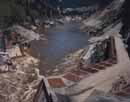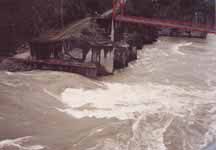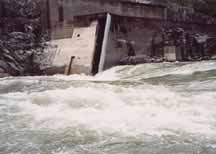|
|
|
1937–1985
With the evidence of few salmon returning to the Fraser River in the years following the 1914 rock slide at Hell's Gate, efforts were made by the governments of Canada and USA as well as the fishing industry, to form a partnership to rectify the passage problem in the Fraser Canyon and specifically at Hell's Gate.
No progress was made until 1937 when a joint Canada/USA Fisheries Commission was formed. This commission, named International Pacific Salmon Fisheries Commission (IPSFC), initiated immediate biological and engineering investigations for the purpose of solving the passage problem and rehabilitating the once historic salmon runs. By an engineering/hydraulic perspective and on the advice of the Commission’s engineering consultants, Professor C.W. Harris, Ted Pretious, P.Eng. & Dr. Henry Gunning, it was decided to leave the river margins as they were and build fishway structures to assist the salmon through the rapids at the known block stages. Consequently, the scheme devised by the engineers was to aid the natural river with fishways to perform its function without destroying the natural hydraulics.
Using topographic and hydraulic survey data from Hell's Gate carried out by the Board of Engineers Enquiry, 1926-1928 combined with additional field data obtained by IPSFC engineers, the Commission built an undistorted 1:50 scale model of the river (in concrete) at the University of Washington in Seattle in 1942. Extensive model tests showed conclusively that streambed clearing of slide material or excavation from either riverbank at Hell's Gate would be unwise. Furthermore the tests indicated that removal of rock from the bottom or sides of the river would result in unpredictable hydraulics as the flow changed, conditions which would be difficult to manage if obstruction to fish migration was to be solved. Jim Pyper, a Commission engineer carried out the model studies, and the results were instrumental in evolving the novel vertical slot fishways designed and built for the first time at Hell’s Gate.
|
|
|
|
|
|
|
|
 |
|
 |
|
 |
|
| Hell's Gate Model 1:50 scale, 1943, looking downstream |
Hell's Gate Model, 1943, testing of hydraulics through west bank fishways |
Hell's Gate Model, 1943, looking towards fish entrances for west bank fishways |
|
|
|
Click on images to enlarge
|
|
|
|
|
|
|
The first phase of construction at Hell’s Gate commenced in 1944 with a major fishway on either riverbank, completed in 1946. The fishways were designed so that the natural hydraulics of the river would not be adversely affected. The design parameters took into account the size and swimming abilities of Pacific salmon and the expected number of fish to be accommodated. |
|
|
|
|
|
|
 |
 |
|
 |
|
 |
|
|
| Hell's Gate, 1944-46, rock excavation & construction for fishways on west bank |
|
Hell's Gate, 1946, main fishway on west bank completed |
Hell's Gate, 1944-46, construction of the main fishway on east bank |
|
Hell's Gate, main fishway on east bank completed in 1946 (photo from 1986) |
|
|
Click on images to enlarge
|
|
|
|
|
|
|
|
Survey of river hydraulics after the fishways were completed confirmed the expectations of the model studies and the number of salmon utilizing the fish passes exceeded predictions. Subsequent to the construction of the first fishways completed in 1946, additional structures were built and completed at Hell’s Gate in 1947, 1951, 1965, 1966, 1989 & 1994. |
|
|
|
|
|
|
 |
|
 |
|
 |
|
|
|
Hell's Gate, 1990, upstream view of fishways, east and west banks |
|
|
|
Hell's Gate, 1989, fishways on east bank looking upstream |
|
Hell's Gate, 1994, upstream view showing low water fishways on east bank |
|
|
|
|
|
|
|
 |
|
 |
|
 |
|
|
| Hell's Gate, 1990, upstream view of low level fishway on east bank, built 1989 |
Cut-away view of a vertical single slot fishway |
|
Hell's Gate Suspension Bridge built by IPSFC after the 1948 flood |
|
|
|
|
|
|
|
 |
|
 |
|
|
|
Hell's Gate, looking towards east bank, showing upper and high level fishways, main fishway submerged, high water |
Hell's Gate, looking towards west bank, showing west bank main fish entrance, low water |
|
|
Click on images to enlarge
|
|
|
|
|
|
|
In addition to fish passage structures at Hell’s Gate, Commission engineers designed and built two fishways at Bridge River Rapids, four at Farwell Canyon on the Chilcotin River and four at Yale Rapids. Other major structures designed and built are spawning channels and associated water supply structures, two at Seton River, one at Weaver Creek, Gates Creek & Nadina River and several other enhancement facilities. The present suspension bridge across the Hell’s Gate gorge was designed and built by IPSFC in 1949 after the original bridge, built for construction of the fishways was wiped out in a major flood in May 1948. |
|
|
|
|
|
|
|
|
|
|
|
|
|
|
|
|
|
|
|
|
|
|
|
|
|
|
|
|
|
|
|
|
|
|
|
|
|
|
|
|
|
|
|
|
|
|
|
|
|
|
|
|
|
|
|














